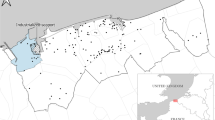Abstract
In this work are presented results of the complex study of two significant solid environmental samples: gravitation dust sediments (industrial pollutants, potential source of risk elements input to soils) and soils (component of the environment, potential source of risk elements input to food web). The first phase of this study was focused on the study of the significant chemical properties (phase composition, content of organic and inorganic carbon) of the dust and soil samples. In the second phase, the fractionation analysis was used on the evaluation of the mobility of chosen risk elements (Cu, Ni, Pb, Zn) in the studied samples. The single-step extractions were applied in the order of the isolation of the element forms (fractions), with different mobilities during defined ecological conditions by utilization of the following reagents: 1 mol dm − 3 NH4NO3 for isolation of the “mobile” fraction, 0.05 mol dm − 3 ethylenediaminetetraacetic acid and 0.43 mol dm − 3 CH3COOH for isolation of the “mobilizable” fraction, and 2 mol dm − 3 HNO3 for isolation of all releasable forms. On the basis of the results obtained in this study, it is possible to state that different origins and positions of solid environmental samples in the environment reflect in different chemical properties of their matrix. The different properties of the sample matrix result in different mobilities of risk elements in these kinds of samples. The fractionation analysis with single-step extraction for isolation element fractions is the method most suitable for easy checking of environmental pollution and for evaluation of risk elements cycle in the environment.
Similar content being viewed by others
References
Abollino, O., Giacomino, A., Malandrino, M., Mentasti, E., Aceto, M., & Barberis, R. (2005). Assessment of metal availability in a contaminated soil by sequential extraction. Water, Air, and Soil Pollution, 137, 315–338.
Alvarenga, P., Palma, P., Gonçalves, A. P., Fernandes, R. M., Varennes, A., Vallini, G., et al. (2008). Evaluation of tests to assess the quality of mine-contaminated soils. Environmental Geochemistry and Health, 30(2), 95–99.
Bacon, J. R., & Davidson, Ch. M. (2008). Is there a future for sequential chemical extraction? Analyst, 133, 25–46.
Cid, B. P., Gonzáles, M. J., & Goméz, E. F. (2002). Comparison of single extraction procedures, using either conventional shaking or microwave heating, and the Tessier sequential method for the fractionation of heavy metals from environmental samples. Analyst, 127, 681–688.
Filgueiras, A. V. , Lavilla, I., & Bendicho, C. (2002). Chemical sequential extraction for metal partitioning in environmental solid samples. Journal of Environmental Monitoring, 4, 823–857.
Jalali, M., & Khanboluki, G. (2008). Redistribution of zinc, cadmium, and lead among soil fractions in a sandy calcareous soil due to application of poultry litter. Environmental Monitoring and Assessment, 136, 327–335.
Kubová, J., Matúš, P., Bujdoš, M., Hagarová, I., & Medveï, J. (2008). Utilization of optimised BCR three-step sequential and dilute HCl single extraction procedures for soil–plant metal transfer predictions in contaminated lands. Talanta, 75, 1110–1122.
Madrid, F., Biasioli M., & Ajmone-Marsan, F. (2008). Availability and bioaccessibility of metals in fine particles of some urban soils. Archives of Environmental Contamination and Toxicology, 55, 21–32.
Norris, P., Chen, C. W., & Pan, W. P. (2010). A technique for sequential leaching of coal and fly ash resulting in good recovery of trace elements. Analytica Chimica Acta, 663, 39–42.
Rao, C. R. M., Sahuquillo, A., & Lopez-Sanchez, J. F. (2010). Comparison of single and sequential extraction procedures for the study of rare earth elements remobilisation in different types of soils. Analytica Chimica Acta, 662, 128–136.
Remeteiová, D., Sminèáková, E., & Flórián, K. (2007). Study of the chemical properties of gravitation dust sediments. Microchimica Acta, 156, 109–113.
Romaguera, F., Boluda, R., Fornes, F., & Abad, M. (2008). Comparison of three sequential extraction procedures for trace element partitioning in three contaminated Mediterranean soils. Environmental Geochemistry and Health, 30(2), 171–175.
Templeton, D. M., Ariese, F., Cornelis, R., Danielsson, L. G., Muntau, H., van Leeuwen, H. P. et al. (2000). Guidelines for terms related to chemical speciation and fractionation of elements. Definition, structural aspects, and methodological approaches. Pure and Applied Chemistry, 8 (72), 1453–1470.
Tokalioǧlu, Ş., & Kartal, Ş. (2005). Comparison of metal fractionation results obtained from single and BCR sequential extractions. Bulletin of Environmental Contamination and Toxicology, 75, 180–188.
Ure, A. M., Davidson, C. M., & Thomas, R. P. (1995). Single and sequential extraction schemes for trace metal speciation in soil and sediment. In Quality assurance for environmental analysis (pp. 505–523). Elsevier Science B. V.
Zhao, J., Peng, P., Song, J., Ma, S., Sheng, G., & Fu, J. (2010). Research on flux of dry atmospheric falling dust and its characterization in a subtropical city, Guangzhou, South China. Air Qual Atmos Health, 3(3), 139–147. doi:10.1007/s11869-009-0062-y.
Wang, X. S., & Qin, Y. (2007). Leaching characteristic of heavy metals and as from two urban roadside soils. Environmental Monitoring and Assessment, 132, 83–92.
Author information
Authors and Affiliations
Corresponding author
Rights and permissions
About this article
Cite this article
Remeteiová, D., Rusnák, R., Kucanová, E. et al. Environmental study of two significant solid samples: gravitation dust sediment and soil. Environ Monit Assess 184, 1121–1130 (2012). https://doi.org/10.1007/s10661-011-2026-6
Received:
Accepted:
Published:
Issue Date:
DOI: https://doi.org/10.1007/s10661-011-2026-6




